|
Ship's
Log: Updated July 8, 2007
Some New Pictures and Some More News
The dinghy floats! And the transom doesn't leak, either. Major step forward! We'll take it to sunset cocktails and dinner at a nice restaurant on the west side of the island for Sharon's birthday celebration.
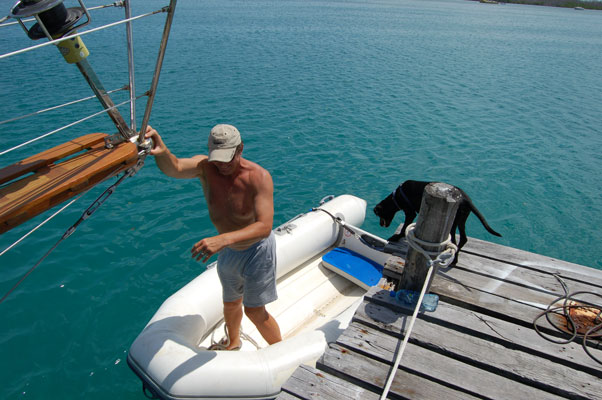
Speaking of sunsets, here's the sunset view from our dock. The fantastic snorkeling area is all along the rocky reef near the small lighthouse.
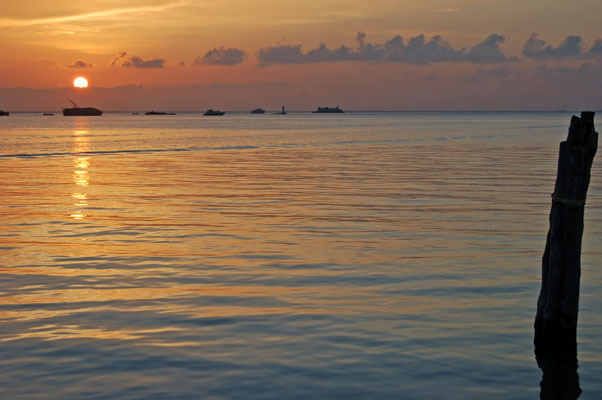
Here's a fruit bought recently at the local market. Anyone know what it is?
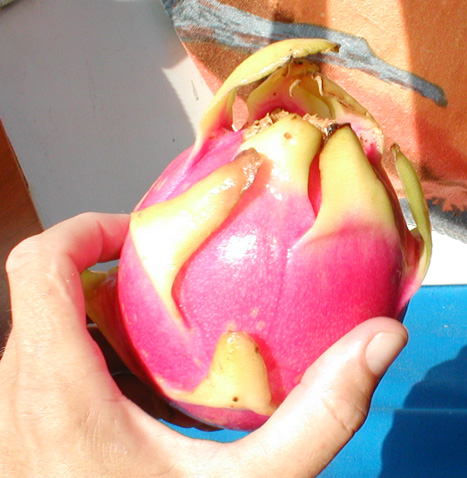
When cut open, the flesh inside is white with tiny black seeds. It's very mild tasting, slightly sweet, and the seeds are slightly tart. It tastes best cold, with a squeeze of lime. And no, this is not a quiz, as we don't know what it is, either!
Where to Go and What to Do: Mañana Syndrome Strikes In Isla Mujeres, Mexico (July 4, 2007)
Virtually every circumnavigator cruiser we have ever talked to or read about has said that in retrospect, they wished they had spent more time in Mexico. So, maybe we are trying to learn from their mistakes!
We had a slow recovery from our sleep-deprived nights crossing the Yucatan Channel, and have made some headway on repairs. We are especially happy with the new bilge pump installation. It was a long, hot and dirty project, with Tracy head down in the greasy bilge for many hours, but it's working now, and it's a gusher!
The dinghy is looking almost normal, after Tracy's long, hot and tedious work taking the pontoons completely off the transom, cleaning everything with acetone, gooping it all with 5200™ marine sealant, and clamping it all back together. The goop is still curing, so we don't know yet whether the effort was worth all the trouble, but it sure is looking better than it did!
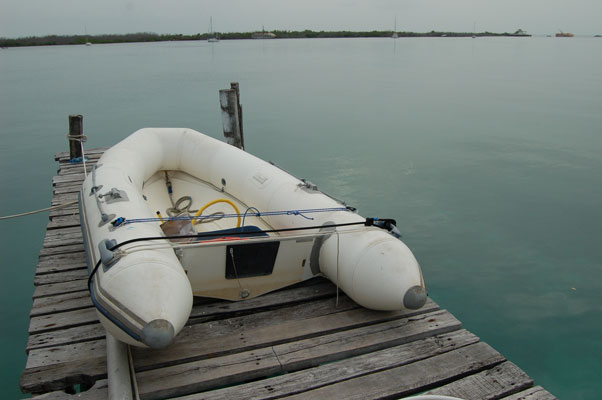
We discovered during our crossing that the whisker stays supporting the bowsprit and bobstay were wet-spaghetti-loose, and probably one cause of our water intake during the crossing. Tracy tightened them up, and then borrowed a rigger's gauge from a fellow cruiser to check the tension on the whisker stays, and then on the whole rig. It's all now tight and looking fine, but we're especially glad we had all the standing rigging replaced before we left.
While we were out one afternoon, an extra-large wake must have come in, because we returned to a broken caprail, a big hunk splintered off the hull and nasty-jagged. The caprail must have caught on the dock, and the weight of the boat snapped the wood. Tracy cut out the bad part,
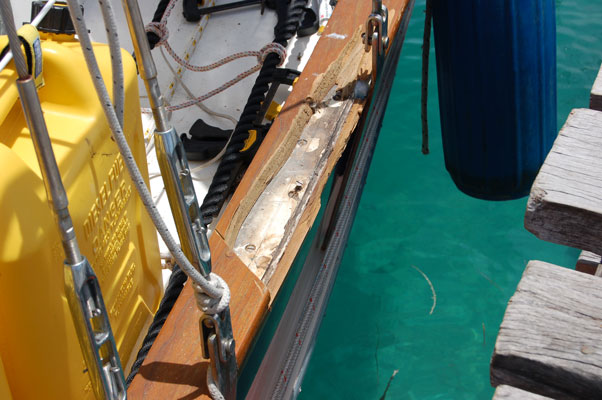
sanded and cleaned it (with Jasmine supervising),

and gooped and clamped it back into place.
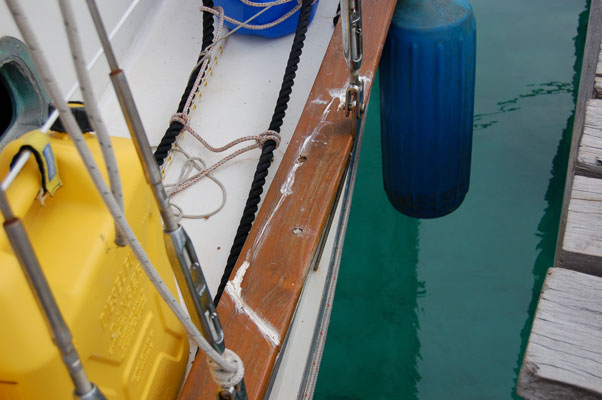
That guy can fix anything!
So. We still need to fix the navigation lights (replace, really; the last fix didn't work for long enough), and adjust the main mast spreaders that drooped during the crossing. And I am sure we will add to the list, as it seems that for every task crossed off the list, two more get added! Well, already I've thought of a very important one: figuring out how to get to Bocas del Toro, Panama!
We have the two big Western Caribbean charts taped to the bulkhead, and we keep looking at them, saying "How in the world are we going to get the 800-odd miles from here to there, against the prevailing currents and wind?" And how long will that take? Can we trust the weather to stay settled?
We have had some time to have fun, though! Our first Saturday night here, we went into town with our dock-neighbor Mike (he of the broken-mast boat), who seems to know everyone. He treated us to a tour of "downtown," and we spent the end of the evening with his friends from Quebec, listening to a Cuban band play in an upstairs bar. It was "the happenin' place" for the evening, and we were glad he introduced us to it, as we've been back there twice since then!
We rode our bikes the three miles to the south end of the island to see the Maya ruins, and walked through a huge sculpture garden that has been created along the paths leading to the ruins. (Forgot the camera, sorry! We'll go back and take pictures.)
Jasmine gave us both heart attacks the other morning--we both went to walk
Gellie, and when we got back, Jasmine was gone. I mean, GONE. We found
her after about fifteen minutes of calling her...under the dock about 10
feet behind the boat! She must have gotten spooked by something, and flown and landed in the water, apparently
paddled her way with her wings to a piling, and had her feet latched onto the
algae, keeping her head above water. Yikes! Tracy went for a swim and
fetched her. She was very happy to hop onto his hand! She was actually
chuckling when he got her, the silly nut.
Gellie has adapted to life near land exceptionally well, taking her morning, afternoon and evening walks in the grass, chasing the many iguanas on the marina grounds, and playing catch with the immature coconuts that we use for go-fetch balls. She tries to play with the resident cats, but they just stare her down with hisses and swats of their sharp claws. We let her off her leash more often than not, and she's so far been very sensible, if not always well-behaved. :-)
We are docked next to some of the local ferries. In the background is one of the "olden days" ferries, and next to it, one of the more modern ferries. The story has it that the olden days ferry was designed and built by a local guy, using no written plans; he just built it! And it was used for years before the new ferries came online.
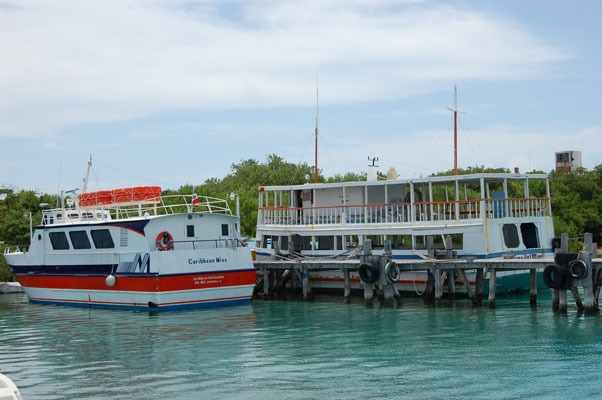
A couple of days after we got here, cruisers from two different boats invited us to a potluck. We asked what we could bring, and when Rick said he was going to the local fish coop, we offered to go in on a fish with him. He found a huge grouper at the local fish co-op that he grilled on the marina's wood-burning grill, using a local anchiote chili paste--yum!! We called it our "group grouper" of course! All the cruisers at the marina were at the potluck, and though it was our very first cruising potluck, it's going to be awfully hard to beat!
We may be succumbing to the heat-induced, island-time, "mañana" syndrome. Things all happen very slowly down here...and our planning, and repairs, are definitely slowing down. A local fisherman has offered us use of his hurricane hole in the mangroves, should we decide to stay for the season. We'll go look at it tomorrow. Isla Mujeres is fast becoming a hard place to leave.
Because we still haven't decided exactly what we're doing, we took a ferry into Cancun Monday, on a provisioning trip to Costco, my favorite store--what fun! This one was not nearly as large or well-stocked as the US Costcos, but it had a lot more than the local supermarket here. Tracy went back to Cancun today, to hit the WalMart for additional supplies that aren't available on the island (or that are just too expensive here). One thing we're very surprised by is the complete lack of canned meals like ravioli, corned beef hash, Spam, open-and-eat things we rely on when making long passages, especially in bad weather or high seas when using the stove is out of the question.
On the plus side, though, fresh produce here is plentiful, and we've had guacamole and freshly made salsa almost every day since we've been here. We are also experimenting with veggies and fruit that are new to us, too. We bought a very beautiful and strange looking new fruit today at the local market that we'll take a picture of and post as soon as we can.
For now, we need to go start on dinner. Our Quebecois friends leave for Quebec tomorrow, so we're having a last evening potluck, and Mike and they are arriving soon. We're grilling chicken and making guacamole and salsa, Mike's contributing Argentinean beef to grill, and the French are bringing the wine...of course!
Stay tuned...
Key West to Isla Mujeres, Mexico
With no serious weather predicted for the next few days, we dropped the mooring ball in Key West at noon on Thursday, June 14, and headed out for the 350 mile run to Isla Mujeres (Island of Women), Quintana Roo, Mexico. We made it in four days, arriving Monday around noon. We managed to avoid the reefs heading to the Dry Tortugas despite the blackness of a moonless night (thank you, GPS). We crossed the rambunctious Yucatan Channel in a rollicking, bashing, bruising two days. It was a lot easier staying off the reefs than it was crossing the Yucatan Channel!
In fact, a boat very much like ours left the same dock we are now on in Isla Mujeres on Saturday for the Yucatan Channel, sailed in the channel Saturday and Sunday like we did, and limped back in the night after we arrived, looking like this--with two broken masts--so it really was a bit rough out there! (Landfall's two blue masts can be seen at the far end of the dock, with Tracy working on our gear.)
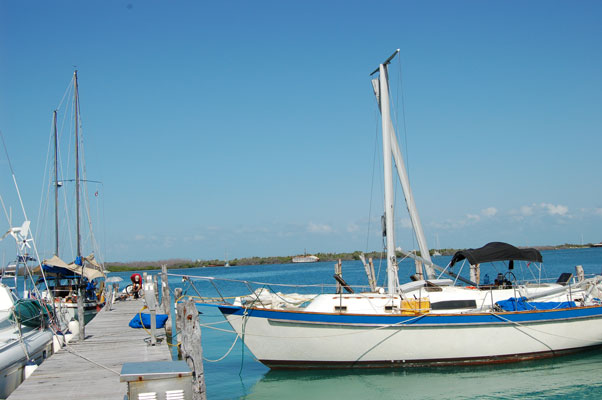
Needless to say, we were too busy dealing with the weather to do any fishing!
Squalls on the Horizon
Toward the end of the first day there were lots of stormy-looking clouds to the south, west and east, but they looked more like typical summer afternoon buildups rather than an organized system. Turned out to be true, as we were dodging similar squalls again the next afternoon. And the next morning. And the next afternoon.

We don't mind the rain in the squalls, but we do want to avoid the potential for being struck by imbedded lightening and very strong gusts.
Wind shifts are common near squalls, and one wind shift took us by surprise. One unexpected jibe later, we had a broken GPS antenna cable, snapped by the boom. Fortunately, Tracy can fix just about anything, and this was one of the many things he fixed along the way.
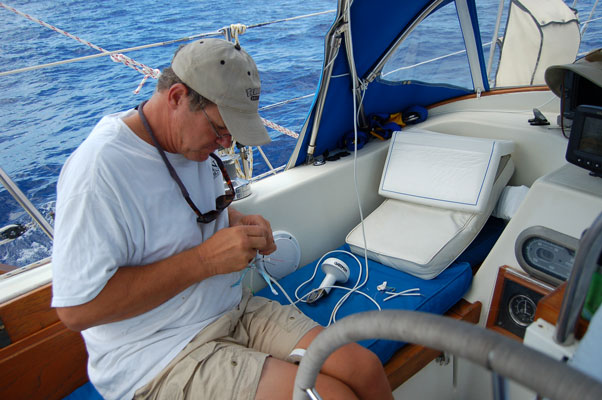
Reluctant Crew
Ray and Monty, our two other "crew," were not on duty when we left. Ray, the autopilot, was completely off duty; he had his head on backwards and would not hold the boat on a heading at all. We had to hand steer the whole first day and night. Hoping to cajole him into working for us, we lost a good hour of cruising time going around in long slow circles trying to get him adjusted, to no avail. The next day, Tracy realized that Ray's internal compass was probably mounted too close to large metal objects (engine, scuba tanks, etc) and was also mounted backwards. He moved Ray's compass and remounted it, and Ray was able to get his head synched up with magnetic north. Good thing, because we really didn't want to hand steer another night!
But Ray wasn't done complaining. Once we put sails up, he wimped out. Just not strong enough to deal with the extra pressure on the helm from the sails. So, we hand-steered while the sails were up, and at night, lowered most of the sails so Ray could steer.
What about Monty the windvane? Why not just take Ray off duty and put Monty to work? Well, it's a real balancing act to get Monty's steering gear locked down into place off the aft deck even in calm seas, and by the time we noticed Ray was really flailing around, it was dark and windy and the waves had built up. We decided we'd forgo the extra speed the sails would give us that night, to avoid the hazard of hanging off the slippery, pitching aft deck on a moonless night.
Monty came on duty late the next morning, though it took us an hour to figure out which line went where and did what (sleep deprivation is an amazing brain-clogger). Once engaged, however, Monty was a loyal, hard-working member of the crew for the rest of the trip--again.
We just can't imagine how short-handed sailors in the olden days managed without Ray and Monty on board. But we expect they were always very, very tired!
Traffic Ahead!
During an offshore passage, one of us is always on watch. During the day we are both often up, but at night, starting at 8pm, one sleeps while the other takes a 2-hour watch. The first night is easy; the second night is a challenge, and by the third night, we are so tired that it's often hard to stay awake while on watch. We have little tricks we play on ourselves to stay awake. Sometimes, though, other ships play tricks on us, and that keeps us very much awake!
Day 3, at 2 o'clock on a dark night about 60 miles north of Cuba, we encountered a cable-laying ship towing a 5-mile long cable, operating in a zigzag pattern, 10 degrees off our heading and just 10 miles away. He hailed us on the radio to warn us that he was laying cable and unable to stop, and that we had better stay at least 3 miles away, because he had a 5 mile long tow. He was generally headed on a 220 degree course, but zigzagging from 170 through 270 degrees to lay the cable; we were on a 230 degree course. It was almost impossible to tell how far away we were from him, and every time we thought we had it figured out, he'd make a turn on his zigzag route. We slowed down, changed our heading, and tried very, very hard to stay out of his way. We were so glad we had radar, but even with that, it was a knuckle-biting, stomach-churning 6 hours until we finally put him solidly astern. With such a large ship and tow so near, no one slept much that night!
More normal shipping traffic also appeared and disappeared regularly, and the radar was invaluable for alerting us to their presence long before they were visible with the naked eye. Our radar sees out 16 miles, and as long as we check the radar every 20 minutes or so, we usually are not surprised. More common than cable-laying ships are tankers, container and grain ships, like this one we saw passing under a rainbow after a big squall blew through.
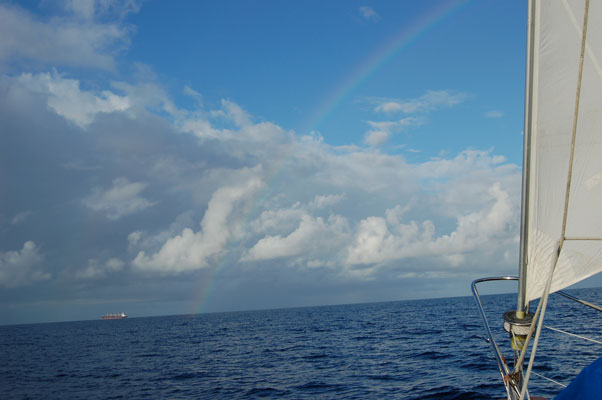
Getting our Sea Legs
One of the less obvious problems we encounter on passage is simply being able to get around the boat without getting bruised. Once the seas are up, every step taken must be taken carefully. We didn't notice this as much in our Pacific passage, but the Gulf of Mexico is very different because the waves are so much closer together. The boat isn't though one wave before the next one hits. At two feet it's not much of a problem, but once they start hitting the 4-6 foot range, the boat just never relaxes, always pitching. We had hours of 6-8 footers, with a lot of 10 footers thrown in for good measure the last day out, and as tired as we all were, it was absolutely exhausting just moving from one place to another.
Magellan is becoming a true "Salty Dog," now able to sleep despite 10 foot waves burying the rail just outside her napping spot.
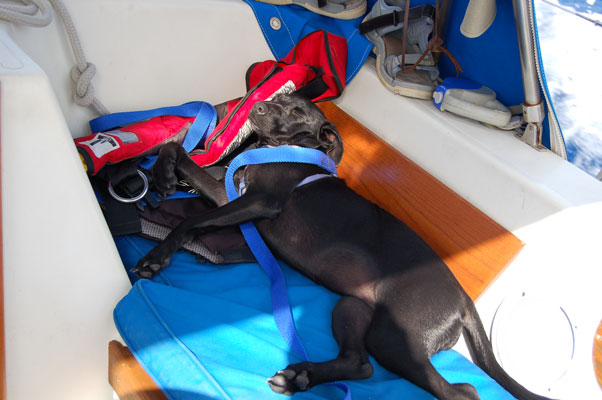
Look Out, You Can't See Us!
The bowsprit plowed through one too many waves on the second night, and as on the trip from Pensacola, shorted out the (newly repaired) navigation lights. Since they are all on the same circuit, that meant that not only the red and green bow lights wouldn't work, but that the stern light and the red night compass light went out, too. So we had the bow light on the main mast, and turned on the anchor light on the mizzen mast, and hoped for the best. When any vessel got close, we turned on the spreader lights to light up the whole deck. It worked. Not legal, but it worked.
Wet Bilge Woes
Ok, we have a small leak. Nothing big, but we bought a new 2000 GPH (gallons per hour) bilge pump before we left, just for good measure. It worked fine the day before we left Key West. It seized up completely the second day out. So Tracy pulled it out (no easy feat underway) and put the old smaller one back in. It quickly quit, too. What to do? The bigger the seas, the more sea in our bilge. And the seas were getting bigger. We have a manual pump, but we were tired enough as it was without having to pump it 150 times every hour. And what if It broke? We had to have a working electric bilge pump.
In Key West, we'd been using a small 360 GPH bilge pump to pump out the leaking dinghy (another story). Tracy fastened a second hose onto the hose for that bilge pump, to make it longer, then fastened that bilge pump to the end of a boat hook. He spliced a cigarette lighter plug onto the wiring, stuck the bilge pump down into the bilge and the hose out the aft cabin hatch, plugged it into the 12-volt plug in the aft cabin, and Voila! Slow, but it worked! One of us would plug it in and drain the bilge every hour or two, and we came in dry. It is good to have more water going out of a boat than coming in! ;-)
Besides, we were getting ever closer to sighting our destination, and the worst part of the 3.5 to 5 knot current in the Yucatan Channel seemed to be working with us rather than against us. On Monday morning when the sun came up we were doing our best sailing....5, 6 even 7 knots at one point, GIDDY-UP! To make things even more exciting, Tracy spotted a pilot whale off of our port bow...WOW! A first for us outside the Pacific. The sails had us flying across the waves, the seas began to calm, Monty was steering the boat like a horse headed for the barn, and most importantly, we both felt like we were going to be sleeping that night rather than having to stand off the coast on another moonless night with no navigation lights. All of the hard work for the past several days seemed worthwhile as the goal came into sight!
Landfall!
Just after 1300 hours on Monday, June 18, we sighted land. Isla Mujeres, a skinny, 4-mile long island off the coast of the Yucatan Peninsula, state of Quintana Roo, Mexico. Two hours later, Miguel and Rick at Marina Paraiso were grabbing our dock lines, and we were here.
Unfortunately, the Mexican Navy caught two boat loads of Cubans trying to sneak into the country about the same time we arrived! Arrgh, I guess the USA is not the only country with an immigration issue. Anyway, since Isla Mujeres is so small, and so close to Cuba, this is a regular event, but it takes up the entire immigration staff to deal with the problem. Here, they treat the violators the same way they treat drug smugglers. The two speed boats were confiscated and the operators will spend many years in a Mexican jail while the 60 or so Cuban refugees will be deported. Anyway, this means that we couldn't clear customs on Monday, and since the office staff was there until late into the night, we couldn't go in too early on Tuesday either. We also had to have someone from the hospital (Health Department) clear our other crew members in (Gellie and Jasmine) before we could go to Customs.
Fortunately, the lady from the health department showed up mid-morning Tuesday to look at the pet papers and gave us clearance. When we got to the Customs office around noon, the official there was professional and courteous, despite being there until past 11:00 the night before. But now it was too late to make it to the Port Captain's office to clear the boat. So, on Wednesday morning we boarded the ferry to Puerto Juarez to clear the boat. As in the other two offices, we found the staff to be helpful and professional. As our papers were in order, for ourselves, the animals and the vessel, we were finally, after three days, free to move around the country and take Gellie off the boat to do her business. Counting our blessings, the couple on the boat arriving two days before us finished the process at the same time, taking five days to clear in rather than the three it took us. LOL, we are good to go! So, tonight we are heading out to dinner to celebrate!
In Isla Mujeres
We're in a marina because our dinghy transom has completely separated from the pontoons, so we'd have no way to get to shore if we anchored. But Marina Paraiso is reasonably priced, has wireless Internet access, and is convenient for all the reprovisioning and repairs we need to make. back
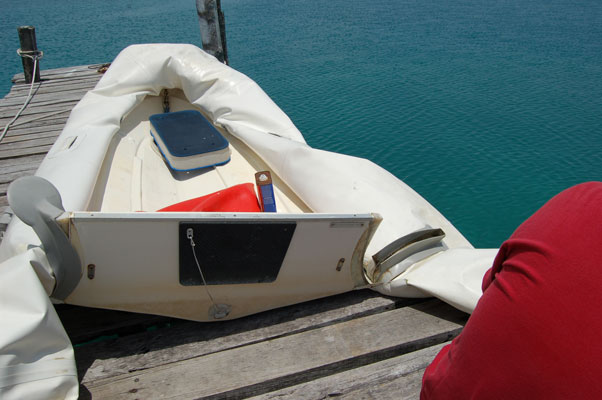
We'll be here for at least another week.
Stay tuned.
Back to Current Log
|
![]()